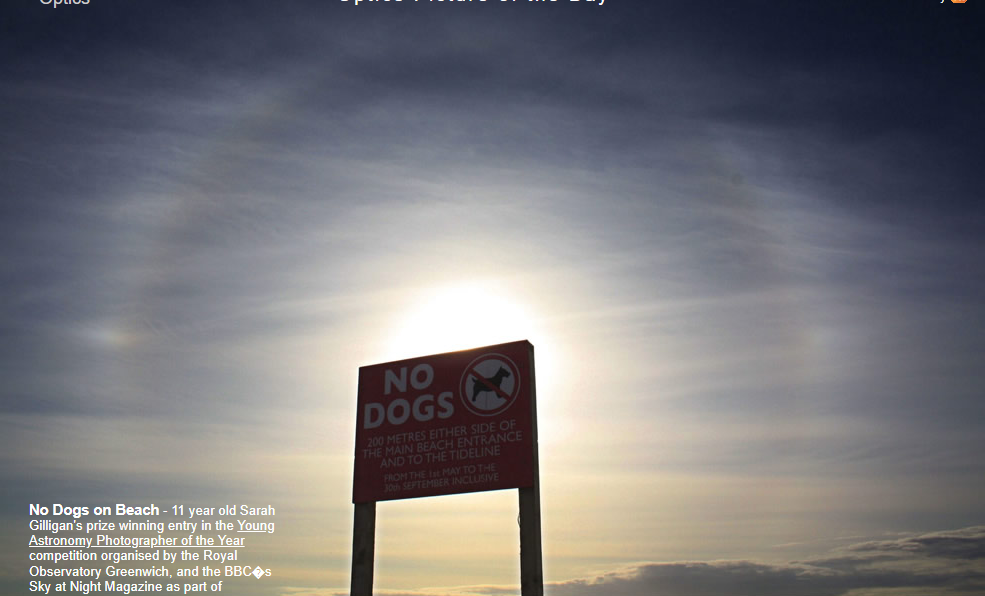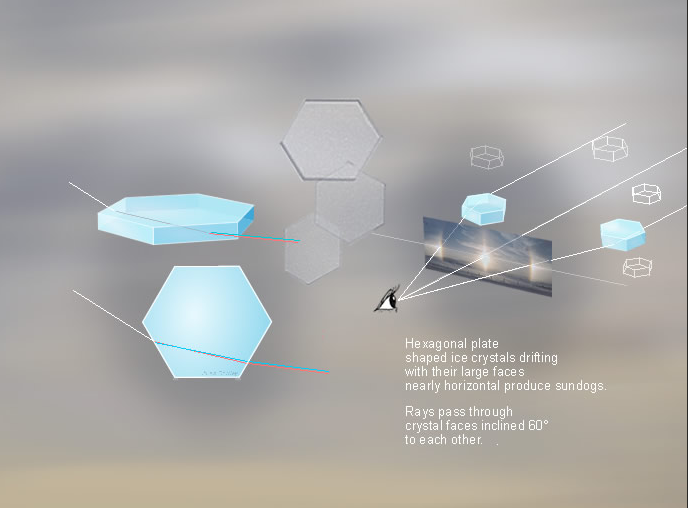No Dogs (except sundogs) allowed
No Dogs (except sundogs) allowed: Exploring the Phenomenon of Sundogs
Sundogs, also known as parhelia, are a captivating atmospheric optical phenomenon that can add a touch of magic to our skies. These beautiful smudges of color, often seen on either side of the sun, are caused by the interaction of sunlight with ice crystals in the atmosphere. While they may not be as frequent or as vibrant as the ones we see on websites, even the faintest sundogs can provide us with optical adventures and remind us of the wonders of our atmosphere.
When the sun is low in the sky, you can try to spot sundogs by shielding the sun and looking on either side of it. By using your outstretched hand as a reference, you can judge the distance between the sun and the sundogs. On average, you may be able to observe a sundog twice a week or so, but their appearance is always a delightful surprise.
The term "sundog" comes from the Greek words "parēlion," meaning "beside the sun," and "helios," meaning "sun." This name accurately describes the positioning of sundogs in relation to our star. They typically appear as two bright spots of light, one on each side of the sun, and are often accompanied by a hazy 22-degree circular halo.
To capture the essence of sundogs, young astronomer Sarah Gilligan entered her prize-winning photograph in the Young Astronomy Photographer of the Year competition. Her image beautifully depicts the sundogs she observed, with their smudges of color against the sky. Sarah's photograph reminds us that even fleeting moments of optical brilliance can leave a lasting impression.
Sundogs are created when sunlight interacts with ice crystals in high-altitude clouds, known as cirrus clouds. These tiny ice crystals act as prisms, bending and refracting sunlight to create the colorful display we see as sundogs. The specific shape and orientation of the ice crystals determine the angle at which the light is scattered, resulting in the distinct appearance of sundogs.
While the spectacular images of sundogs found on websites may be less common in reality, the more subtle and faint sundogs are no less enchanting. These less vibrant displays serve as a testament to the ongoing presence of ice crystals in the cirrus clouds, faithfully providing us with optical wonders. The delicate dance between sunlight and ice crystals continues to paint our skies with moments of awe-inspiring beauty.
It's important to note that sundogs are just one example of the many atmospheric optical phenomena that can occur. These phenomena are a result of the complex interplay between light, particles, and atmospheric conditions. From rainbows to halos, each phenomenon offers a unique insight into the workings of our atmosphere.
In conclusion, sundogs are a captivating atmospheric optical phenomenon that can add a touch of wonder to our skies. While they may not appear as frequently or as vibrantly as the ones captured in photographs, even the faintest sundogs can provide us with moments of optical adventure. So, next time you find yourself gazing at a low sun, take a moment to look beside it and see if you can catch a glimpse of these delightful smudges of color. After all, in the ever-changing tapestry of our atmosphere, there's always something new and fascinating to discover.

No Dogs on Beach - 11 year old Sarah Gilligan's prize winning entry in the Young Astronomy Photographer of the Year competition organised by the Royal Observatory Greenwich, and the BBC�s Sky at Night Magazine as part of International Year of Astronomy 2009.
Sarah of Liverpool, England was runner-up with this image of sundogs each side of the sun and a hazy 22 degree circular halo. 'I needed something to hide the bright Sun, so the “No Dogs on Beach” sign was the best thing, but we did see the two Sun Dogs or Parhelia which means 'beside the Sun" '.
Sarah's image truthfully portrays the appearance of the sundogs that we most often see - smudges of colour against the sky lasting perhaps a minute or so.
When the sun is low, shield the sun and look each side of it judging distance with an outstretched hand. Check frequently and a sundog will be seen twice a week or so on average. The spectacular ones that are on websites are rather less frequent. However, these faint smudges are as satisfying and remind us that ice crystals high in the cirrus are continuing to do their job in providing us with optical adventures.
© Shown with kind permission.

Note: this article has been automatically converted from the old site and may not appear as intended. You can find the original article here.
Reference Atmospheric Optics
If you use any of the definitions, information, or data presented on Atmospheric Optics, please copy the link or reference below to properly credit us as the reference source. Thank you!
-
<a href="https://atoptics.co.uk/blog/no-dogs-except-sundogs-allowed/">No Dogs (except sundogs) allowed</a>
-
"No Dogs (except sundogs) allowed". Atmospheric Optics. Accessed on November 26, 2024. https://atoptics.co.uk/blog/no-dogs-except-sundogs-allowed/.
-
"No Dogs (except sundogs) allowed". Atmospheric Optics, https://atoptics.co.uk/blog/no-dogs-except-sundogs-allowed/. Accessed 26 November, 2024
-
No Dogs (except sundogs) allowed. Atmospheric Optics. Retrieved from https://atoptics.co.uk/blog/no-dogs-except-sundogs-allowed/.